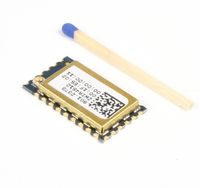Difference between revisions of "ICradio-ZWIR4512-OEM"
| Line 1: | Line 1: | ||
[[file:ZWIR4512.jpg|200px|left|transparent]] | [[file:ZWIR4512.jpg|200px|left|transparent]] | ||
| − | The ICradio ZWIR4512 OEM module is a [http://en.wikipedia.org/wiki/6LoWPAN | 6loWPAN] radio module. The 6LowPAN radio stack is delivered | + | The ICradio ZWIR4512 OEM module is a [http://en.wikipedia.org/wiki/6LoWPAN | 6loWPAN] radio module. The delivered 6LowPAN radio stack is able to build up a meshing network. Every node per default is relaying packets. So the user does not need to care about meshing. Just send packts to the nodes, the network will route the packets to the destination. |
| − | For an easy startup with the ICradio ZWIR4512 OEM, In-Circuit deliveres the modules with an small application software. This software connects to the UART and RF interfaces and handles some packets. | + | The 6LowPAN Stack is delivered by ZMDi. It is a free for use software library in addition of some C-header files. |
| − | + | For an easy startup with the ICradio ZWIR4512 OEM radio modules, In-Circuit deliveres the modules with an small application software. This software is connects to the UART and RF interfaces and handles some packets. | |
| − | + | ||
| − | + | ||
| − | + | ||
| − | + | ||
| − | + | ||
| + | The Demo-Software implemets an UART-to-Radio protocol | ||
Revision as of 20:45, 21 January 2011
The ICradio ZWIR4512 OEM module is a | 6loWPAN radio module. The delivered 6LowPAN radio stack is able to build up a meshing network. Every node per default is relaying packets. So the user does not need to care about meshing. Just send packts to the nodes, the network will route the packets to the destination. The 6LowPAN Stack is delivered by ZMDi. It is a free for use software library in addition of some C-header files. For an easy startup with the ICradio ZWIR4512 OEM radio modules, In-Circuit deliveres the modules with an small application software. This software is connects to the UART and RF interfaces and handles some packets.
The Demo-Software implemets an UART-to-Radio protocol
Some special commands are also implemented and have to be sent via UART to the LOCAL-HOST (::1)
- scanning the network
S00110000000000000000000000000000000105
- getting the module's IPv6 address
S00110000000000000000000000000000000109
- setting the module's LED's
S001300000000000000000000000000000001070100 (set LED1=on, LED2=off) S001300000000000000000000000000000001070001 (set LED1=off, LED2=on)
